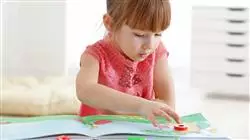University certificate
The world's largest faculty of education”
Introduction to the Program
Through this course you will master the most appropriate exercises for the elaboration of facial praxias that favor the proper pronunciation of phonemes”

Dyslalias are speech disorders suffered by a large number of children during childhood that prevent them from pronouncing various sounds correctly, among which letters and consonant groups stand out. As a result, there is a limitation when speaking in public or participating in school classes, which can lead to anxiety or frustration for children. Because of this, establishing the most appropriate exercises for their correction, adapted to the characteristics of each type of disorder, is crucial to ensure the welfare of children. Since these tasks are carried out by speech therapists specialized in this field, their figure is very much needed by both parents and educational institutions.
Given this situation, TECH has created this Postgraduate Certificate, with the aim of expanding the student's knowledge in the field of evaluation and treatment of dyslalia to promote their professional growth in this sector. During 6 weeks of intensive learning, the student will delve into the classification of these disorders according to the phonological process involved or chronological criteria and assimilate the new evaluation processes for diagnosis and detection. Likewise, the student will use the existing technological resources for the correction of the pronunciation of different phonemes.
Thanks to the 100% online mode of teaching, characteristic of this program, students will manage their own study schedules as they wish in order to obtain effective learning. Additionally, didactic resources developed by experts with extensive experience in the world of Speech Therapy, who will provide the skills with greater professional applicability in this field.
Manage the most updated techniques to evaluate and diagnose the different types of Dyslalias thanks to this program”
This Postgraduate certificate in Dyslalia contains the most complete and up-to-date program on the market. The most important features include:
- The development of case studies presented by experts in Speech Therapy
- The graphic, schematic and eminently practical contents with which it is conceived provide practical information on those disciplines that are essential for professional practice
- Practical exercises where the self-assessment process can be carried out to improve learning
- Its special emphasis on innovative methodologies
- Theoretical lessons, questions to the expert, forums for discussion of controversial issues and individual reflection papers
- Content that is accessible from any fixed or portable device with an Internet connection
Increase your skills in the management of Dyslalia to access the best professional opportunities in the world of Speech Therapy”
The program includes in its teaching staff professionals of the field who pour into this training the experience of their work, in addition to recognized specialists from reference societies and prestigious universities.
Its multimedia content, developed with the latest educational technology, will allow the professional a situated and contextual learning, i.e. a simulated environment that will provide immersive training programmed to train in real situations.
The design of this program focuses on Problem-Based Learning, in which the professional will have to try to solve the different professional practice situations that will arise throughout the academic course. For this purpose, the student will be assisted by an innovative interactive video system created by renowned experts.
Enroll now in this program to, in only 150 hours, acquire valuable knowledge in the approach to Dyslalia”

Access 24 hours a day to the contents offered in this program in order to achieve an optimized learning proces in a reduced time”
Why study at TECH?
TECH is the world’s largest online university. With an impressive catalog of more than 14,000 university programs available in 11 languages, it is positioned as a leader in employability, with a 99% job placement rate. In addition, it relies on an enormous faculty of more than 6,000 professors of the highest international renown.

Study at the world's largest online university and guarantee your professional success. The future starts at TECH”
The world’s best online university according to FORBES
The prestigious Forbes magazine, specialized in business and finance, has highlighted TECH as “the world's best online university” This is what they have recently stated in an article in their digital edition in which they echo the success story of this institution, “thanks to the academic offer it provides, the selection of its teaching staff, and an innovative learning method aimed at educating the professionals of the future”
A revolutionary study method, a cutting-edge faculty and a practical focus: the key to TECH's success.
The most complete study plans on the university scene
TECH offers the most complete study plans on the university scene, with syllabuses that cover fundamental concepts and, at the same time, the main scientific advances in their specific scientific areas. In addition, these programs are continuously being updated to guarantee students the academic vanguard and the most in-demand professional skills. In this way, the university's qualifications provide its graduates with a significant advantage to propel their careers to success.
TECH offers the most comprehensive and intensive study plans on the current university scene.
A world-class teaching staff
TECH's teaching staff is made up of more than 6,000 professors with the highest international recognition. Professors, researchers and top executives of multinational companies, including Isaiah Covington, performance coach of the Boston Celtics; Magda Romanska, principal investigator at Harvard MetaLAB; Ignacio Wistumba, chairman of the department of translational molecular pathology at MD Anderson Cancer Center; and D.W. Pine, creative director of TIME magazine, among others.
Internationally renowned experts, specialized in different branches of Health, Technology, Communication and Business, form part of the TECH faculty.
A unique learning method
TECH is the first university to use Relearning in all its programs. It is the best online learning methodology, accredited with international teaching quality certifications, provided by prestigious educational agencies. In addition, this disruptive educational model is complemented with the “Case Method”, thereby setting up a unique online teaching strategy. Innovative teaching resources are also implemented, including detailed videos, infographics and interactive summaries.
TECH combines Relearning and the Case Method in all its university programs to guarantee excellent theoretical and practical learning, studying whenever and wherever you want.
The world's largest online university
TECH is the world’s largest online university. We are the largest educational institution, with the best and widest online educational catalog, one hundred percent online and covering the vast majority of areas of knowledge. We offer a large selection of our own degrees and accredited online undergraduate and postgraduate degrees. In total, more than 14,000 university degrees, in eleven different languages, make us the largest educational largest in the world.
TECH has the world's most extensive catalog of academic and official programs, available in more than 11 languages.
Google Premier Partner
The American technology giant has awarded TECH the Google Google Premier Partner badge. This award, which is only available to 3% of the world's companies, highlights the efficient, flexible and tailored experience that this university provides to students. The recognition as a Google Premier Partner not only accredits the maximum rigor, performance and investment in TECH's digital infrastructures, but also places this university as one of the world's leading technology companies.
Google has positioned TECH in the top 3% of the world's most important technology companies by awarding it its Google Premier Partner badge.
The official online university of the NBA
TECH is the official online university of the NBA. Thanks to our agreement with the biggest league in basketball, we offer our students exclusive university programs, as well as a wide variety of educational resources focused on the business of the league and other areas of the sports industry. Each program is made up of a uniquely designed syllabus and features exceptional guest hosts: professionals with a distinguished sports background who will offer their expertise on the most relevant topics.
TECH has been selected by the NBA, the world's top basketball league, as its official online university.
The top-rated university by its students
Students have positioned TECH as the world's top-rated university on the main review websites, with a highest rating of 4.9 out of 5, obtained from more than 1,000 reviews. These results consolidate TECH as the benchmark university institution at an international level, reflecting the excellence and positive impact of its educational model.” reflecting the excellence and positive impact of its educational model.”
TECH is the world’s top-rated university by its students.
Leaders in employability
TECH has managed to become the leading university in employability. 99% of its students obtain jobs in the academic field they have studied, within one year of completing any of the university's programs. A similar number achieve immediate career enhancement. All this thanks to a study methodology that bases its effectiveness on the acquisition of practical skills, which are absolutely necessary for professional development.
99% of TECH graduates find a job within a year of completing their studies.
Postgraduate Certificate in Dyslalia
The Postgraduate Certificate in Specific Language Disorders is a program that allows speech therapy professionals to specialize in the diagnosis and treatment of the most common speech therapy problems in children during their school years. The inability to pronounce some letters or sets of phonemes can limit communication and affect the articulation of sounds when speaking in adolescence and adulthood. Early detection and timely treatment are essential to ensure proper communication and language development. For this reason, specialization in specific language disorders is a job opportunity with guaranteed success. The Postgraduate Certificate, taught by TECH, is 100% online, which allows the student to handle the techniques and exercises for facial praxias from the comfort of their home, without the need to travel.
Specialize in speech disorders
During the course, the student will acquire the necessary knowledge for the diagnosis of dyslalias, one of the most common disorders, as well as for the treatment and correction of facial praxias. In addition, students will deepen their knowledge of the anatomy and physiology of the phonatory system and its relationship with language. The Postgraduate Certificate in Dyslalias is aimed at both speech therapy professionals and people interested in the field of education and health who wish to specialize in the diagnosis and treatment of language disorders. In short, this Postgraduate Certificate offers speech therapy professionals the opportunity to acquire the knowledge and skills necessary to detect, diagnose and treat the most common specific language disorders in children and thus ensure their proper development of language and communication in the future.







